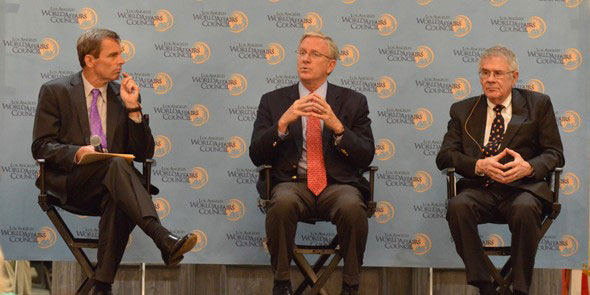 Terry McCarthy with RAND's Charles Ries and Ross Anthony
Terry McCarthy with RAND's Charles Ries and Ross AnthonyMany attempts have been made to hammer out peace plans for the Israeli-Palestinian conflict, which involve dealing with divergent political and security perspectives, but there has been much less attention paid to the economic costs/opportunities of the situation. To remedy that, two senior researchers from the RAND Corporation, Charles Ries and Ross Anthony, started in 2013 to work out how much economic benefits would accrue to both Israelis and Palestinians if a peaceful solution were negotiated, and what the costs would be of a lack of any agreement, or in the worst scenario, a return to outright violence. On Wednesday, October 28th, they presented details of their resulting report, "The Costs of the Israeli-Palestinian Conflict" to a LAWAC dinner.
"The real takeaway is the message in the numbers," said Anthony, who stressed that the RAND report is completely non-partisan and focuses on economic facts and analysis, without making any policy recommendations. "A two-state solution is by far in the best economic interest of both parties," he said. According to the report's detailed calculations, by 2024 in the case of a two-state solution, Israelis would see a 5.2% increase in their GDP, while Palestinians would see a staggering 48.8% increase in their GDP (albeit starting from a lower base). In dollar terms this translates as a gain of $123 bn for Israelis and $50 bn for Palestinians. This compares to the opposite extreme scenario, a return to violence and the negative impact on both Israelis and Palestinians. "Security expenses would go up" said Anthony. If there is uncertainty and unrest, the reaction from the business community would be "investment would go down...tourism is going to go down," said Anthony. The report shows that per capita GDP would decline 10% in Israel and by 46% in the West Bank and Gaza by 2024. The researchers outlined five different scenarios - from a two-state solution, to an all-out violent uprising, to three in-between scenarios: a coordinated unilateral withdrawal of Israelis from the West Bank, an uncoordinated unilateral withdrawal, and non-violent Palestinian resistance. All scenarios are compared to the status quo of the continuing impasse.
"We wanted to put all the facts on the table and present policy makers with knowledge and information without trying to tell them what the solution should be," said Anthony. "This turned out to be a lot more difficult than we thought," he said adding that their analysis extended to details like the economic costs of security, the ability to get visas, and costs to the international community. They collected data and research from 2013-2014 and that was followed by a year-long vigorous external and internal review process. Some figures were surprising - for example the large number of Palestinian prisoners in Israel whom the Palestinians support with financial subsidies that amount to $100 m per year. Presumably many of these prisoners would be released and the subsidy costs would plunge should a peaceful settlement be reached. Other unexpected benefits could include Israel opening up trading relationships with the Arab world, which are currently on hold (apart from some trade with Jordan) because of the Palestinian issue.
An interactive cost calculator was created as part of the report to serve as a tool to further analyze the direct and opportunity costs of each scenario. "It was very important to us to be very transparent," said Anthony. "So all of the assumptions of everything is completely laid out." The calculator lists 22 factors that can be adjusted including trade, tourism, destruction of private property and public infrastructure, access to territorial waters, Palestinian labor in Israel, loosening of banking regulations, improved access to water for agriculture and so on. "If you disagree with this assumption or that assumption, you can actually change it," said Ries.
When asked how they see their report being used, Ries said they have been traveling the world sharing their study and meeting with foreign ministries to help provide some factual material as a basis for ongoing talks. He said his goal is for RAND's data and calculator to be "trusted by both sides and then used for negotiations," he said. "That for us would be a home run."
